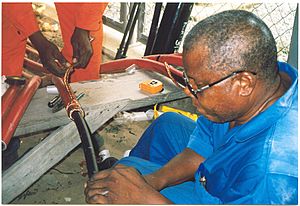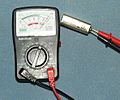Voltage facts for kids
Voltage is like the "push" that makes tiny electric particles, called charges, move. Imagine it as the force that gets electricity flowing through a wire or anything that conducts electricity. When voltage makes charges move, it creates an electric current.
The scientific name for voltage is "Electric Potential Difference," but most people just call it voltage. Sometimes, you might also hear it called "Potential Difference" or even "electromotive force (EMF)" in special situations.
Voltage is basically the difference in electric potential between two points. The unit we use to measure voltage is the volt. This unit is named after Alessandro Volta, a famous scientist. One volt is equal to one joule of energy per coulomb of charge. The symbol for the volt is a capital V, like in "9V" for a 9-volt battery.
It's important to remember that the volt and voltage are different things. The volt is the unit we use to measure something, while voltage is the thing we are measuring. So, you measure voltage in volts. For example, a battery might have a voltage of 9 volts, which you can write as 9 V.
Voltage is always measured between two different points. For example, you measure the voltage between the positive and negative ends of a battery, or between an electrical wire and the ground. In homes in the U.S., the voltage is usually 120V, measured from the wire to the ground.
To get power (or energy) to flow, you need both voltage and current. If a wire has high voltage but isn't connected to anything, nothing will happen. This is why birds can sit on high-voltage power lines without getting hurt – the current doesn't flow through their bodies.
There are two main kinds of voltage: DC voltage and AC voltage. DC voltage, like from a battery, always stays the same, with a constant positive and negative side. AC voltage, like from a wall socket, constantly switches between positive and negative. For instance, in America, the voltage from a wall socket changes direction 60 times every second! DC voltage is often used for electronics, while AC voltage is used for things like motors.
Contents
What is Voltage?
Voltage is the change in electric potential between two places. It can also be thought of as the change in electric potential energy for each unit of charge (coulomb) between two points.
How to Think About Voltage
Imagine voltage as the "pressure" in an electrical circuit. Just like water pressure pushes water through pipes, voltage pushes electric charges through wires. The higher the voltage, the stronger the push.
Ground and Voltage
Voltage is always measured by comparing two points. One of these points is often called "ground," or the zero volt (0V) point. In many electrical systems, especially for AC power, there's a connection to the actual Earth. This connection is made using things like water pipes or metal rods buried in the ground.
Earth as a Reference Point
The entire planet Earth can be used as a reference point for measuring voltage. Inside a building, this "ground" connection is carried by specific wires. One is a safety wire (often green or bare), which connects metal parts of equipment to the Earth. Another is called the "neutral conductor," which is also at ground potential and helps complete the electrical circuits by carrying current back to where the electricity enters the building.
Ground in DC Circuits
In DC circuits, like those in batteries or small electronic devices, the negative end of the battery or power source is often called the "ground" or 0V point. This doesn't always mean it's connected to the actual Earth. Sometimes, in complex electronic circuits, different parts might have their own "grounds," like an "analog ground" for sensitive parts and a "digital ground" for other parts.
Tools to Measure Voltage
To measure voltage, you can use tools like a voltmeter or an oscilloscope.
Using a Voltmeter
A voltmeter measures the voltage between two points. You can set it to measure DC voltage (like from a battery, usually 1.5V or 9V) or AC voltage (like from a wall socket, typically 120V).
Using an Oscilloscope
For more complicated electrical signals, an oscilloscope is used. It can show you how voltage changes over time, which is useful for things like measuring the voltage across a speaker.
Potential Difference Explained
The voltage, or potential difference, between two points (let's call them point A and point B) tells you how much energy (measured in joules) is needed to move one unit of positive charge (one coulomb) from point A to point B.
If you have a negative voltage between points A and B, it means energy is needed to move a negative charge from A to B. In an electric field, negative charges are pulled towards higher voltages, while positive charges are pulled towards lower voltages. The voltage between two points doesn't depend on the path you take to get from one point to the other.
Images for kids
-
Multimeter set to measure voltage
See also
 In Spanish: Tensión (electricidad) para niños
In Spanish: Tensión (electricidad) para niños




